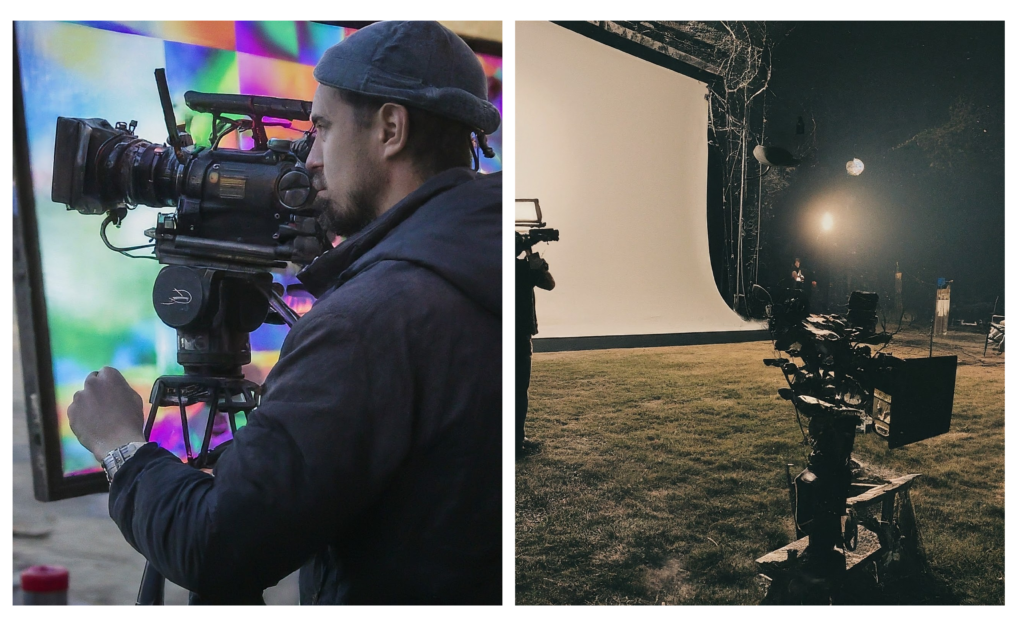Buckle up for an immersive journey into the realm of virtual production as we sit down with James Blevins to learn about its evolution and impact.

Inside the Virtual Set: A Conversation with James Blevins
Greetings Vitrina Community,
Buckle up for an immersive journey into the realm of virtual production as we sit down with James Blevins to learn about its evolution and impact.
Vitrina: Could you share your journey and shed some light on what currently occupies your day-to-day activities?
James Blevins: Certainly. My journey into the realm of technology began at a young age, thanks to the unique opportunity presented by DARPA issuing mainframes to colleges across the United States. As a 12-year-old with access to a mainframe account, I found myself drawn to the world of technology, particularly the aspect of play and experimentation it offered. Growing up in an artistic family, I also had the opportunity to nurture my creative side alongside my fascination with technology.
Throughout college, where I pursued a Bachelor of Fine Arts degree, I continued to delve into building machines and exploring concepts on mainframe systems. Upon entering the professional world, I initially worked on film sets in various capacities before transitioning to a temp job at Synesight, a division of Kodak. Here, I found myself immersed in a world of cutting-edge technology, including silicon graphics equipment, which fueled my passion for solving operational challenges related to data movement and caching.
Over the years, I ventured into roles at Disney, where I served as the Chief Technology Officer (CTO) at Sway, collaborating with visionaries like Joe Kosinski. Subsequently, I joined Netflix, where I witnessed a profound commitment to innovation and technological advancement, particularly in the realm of original content production.
Following my tenure at Netflix, I co-founded a startup called Video Village with a colleague, Daryl Strauss, leveraging the wealth of knowledge and experience gained from my previous endeavors. It was during this time that I had my first encounter with Virtual Production while working on episodic content for Lucasfilm’s “The Mandalorian.”
Fascinated by the potential of Virtual Production, especially in the context of the evolving film and television industry, I founded my own company called Mesh. Recognizing a gap in line producing within this space, Mesh focuses on addressing adoption challenges and providing comprehensive solutions for Virtual Production projects.
Currently, my day-to-day activities revolve around overseeing the operations of Mesh, collaborating with clients, and staying abreast of the latest developments in Virtual Production. Additionally, I compile quarterly reports on the state of Virtual Production, contributing to the ongoing discourse and advancement of this exciting field.
Vitrina: What significant changes have you observed in Virtual Production over the past five years, particularly since your involvement with projects like The Mandalorian?
James Blevins: Over the past five years, Virtual Production has seen significant evolution, especially since my involvement with projects like The Mandalorian. Initially, we were utilizing a technology known as Stagecraft, which revolutionized the way we approached production. However, as we transitioned away from The Mandalorian and ventured into our own endeavors, it became evident that Unreal Engine had become ubiquitous in the Virtual Production landscape. Unreal’s versatility and simulation capabilities quickly garnered widespread adoption within the industry.
Furthermore, there has been a notable shift towards real-time ray tracing, particularly with the advancements made by Nvidia’s DSL 3.5. This development has fundamentally changed the way we approach lighting and rendering in Virtual Production. Real-time ray tracing offers unparalleled fidelity and efficiency, especially for time-sensitive projects like commercials. However, while Unreal Engine remains a powerhouse in Virtual Production, challenges persist, particularly concerning asset delivery and workflow integration.
To engage on that level, because that’s really how this industry, our industry has been founded, is on the backs and on the shoulders of giants who have innovated along the way. And that’s come out of people who are, if not, we’re not engineers, we’re thinking like engineers, and they’re putting this stuff together. So we spend a lot of time building bridges to concepts, to services, and we do hand out some blankets and cocoa, especially when times are rough.
We do a lot of good work telling all of the people, during the strikes, we were telling everyone who would listen that our industry was in trouble. And so we really are interested in doing what’s best for this community. At this point, this is really, this is a community that I’m really proud to be a part of.
Vitrina: Can you elaborate on the challenges and thrilling experiences you've encountered while working on Virtual Production projects?
James Blevins: Working on Virtual Production projects has been both exhilarating and challenging. One of the most thrilling aspects is witnessing the rapid technological advancements that have transformed the industry. From pioneering new techniques to integrating cutting-edge tools, each project presents unique opportunities for innovation.
However, these advancements also bring their fair share of challenges. One significant hurdle is the adoption rate of Virtual Production technologies. Despite its potential, some aspects of the workflow, such as asset delivery and real-time rendering, still face scalability issues. Additionally, navigating the complex interplay between traditional filmmaking techniques and emerging technologies requires careful planning and execution.
Yet, amidst these challenges, there’s an undeniable sense of excitement and possibility. Virtual Production has opened up new creative avenues and expanded the possibilities for storytelling. The thrill of pushing the boundaries of what’s possible in filmmaking drives us to overcome obstacles and embrace the ever-evolving landscape of Virtual Production.
And I want it to succeed, here’s the bottom line, no matter how much change is coming, we’re still going to be making stories. The frame, the framing may absolutely alter, but we’re absolutely going to be doing this thing that we do as humans. We tell these stories.

Vitrina: What trends do you foresee shaping the future of Virtual Production, particularly in terms of technology and industry adoption?
James Blevins: The future of Virtual Production is poised to be transformative, driven by ongoing technological advancements and increasing industry adoption. One significant trend on the horizon is the widespread integration of real-time ray tracing technology. As advancements in hardware and software continue to improve rendering capabilities, we can expect a paradigm shift in how we approach lighting and visual fidelity in Virtual Production.
Moreover, the democratization of Virtual Production tools and techniques is likely to accelerate industry adoption. With the proliferation of accessible software and training programs, a broader range of filmmakers and production teams can harness the power of Virtual Production to bring their creative visions to life.
Additionally, the convergence of Virtual Production with other emerging technologies, such as augmented reality and artificial intelligence, holds immense potential for innovation. These synergies could revolutionize storytelling, enhance production workflows, and redefine the boundaries of cinematic expression.
Vitrina: How do you perceive the impact of cloud-based workflows on the future of filmmaking, particularly in terms of efficiency and accessibility?
James Blevins: Cloud-based workflows represent a paradigm shift in filmmaking, offering unprecedented levels of efficiency, flexibility, and accessibility. With the ability to store, process, and collaborate on content in the cloud, filmmakers can streamline production workflows and overcome traditional barriers to creativity.
One significant impact of cloud-based workflows is the democratization of filmmaking. By reducing the reliance on expensive hardware and physical infrastructure, cloud-based solutions empower independent filmmakers and smaller studios to compete on a level playing field with industry giants. Moreover, cloud-based collaboration tools facilitate seamless communication and collaboration among geographically dispersed teams, fostering a more inclusive and diverse creative process.
Furthermore, cloud-based workflows enable filmmakers to leverage cutting-edge technologies and scale resources on-demand, enhancing production efficiency and reducing time-to-market. From remote editing and color grading to real-time collaboration and asset management, the cloud offers a wealth of possibilities for optimizing every stage of the filmmaking process.
Vitrina: How do you envision the intersection of Virtual Production with other industries, such as gaming, architecture, and aerospace, shaping the future of immersive storytelling and experiential design?
James Blevins: The intersection of Virtual Production with other industries, such as gaming, architecture, and aerospace, holds immense potential for immersive storytelling and experiential design. By leveraging common technologies and methodologies across disciplines, creators can collaborate on groundbreaking projects that transcend traditional boundaries.
In the gaming industry, Virtual Production techniques have already revolutionized the creation of interactive experiences, blurring the lines between cinema and gaming. By integrating cinematic storytelling with interactive gameplay, developers can create immersive worlds that captivate audiences and offer unparalleled levels of engagement.
Similarly, in the architecture and aerospace sectors, Virtual Production enables designers to visualize and simulate complex environments with unprecedented realism and accuracy. Whether designing future cities or exploring distant planets, Virtual Production tools empower creators to bring their visions to life in ways that were previously unimaginable.
Moreover, the convergence of Virtual Production with emerging technologies such as augmented reality and virtual reality opens up new frontiers for storytelling and experiential design. From immersive theme park attractions to interactive museum exhibits, Virtual Production techniques enable creators to transport audiences to new worlds and create unforgettable experiences.
Incorporating the additional dialogue, we get a more comprehensive understanding of the speaker’s perspective and the broader context of Virtual Production and its intersection with other industries.
Vitrina: Speculating on the future of technological adoption, what are your insights into the ongoing changes, particularly regarding AI, and how does the HPA's NET committee contribute to navigating these shifts?
James Blevins: Well, when we consider the trajectory of technological advancements, especially in the realm of AI, it’s clear that we’re on the cusp of significant transformations across various industries. Take, for instance, the analogy of the Luddites from the 19th century, who resisted the introduction of machines that replaced manual labor, leading to job displacement. Similarly, today, we’re witnessing a paradigm shift where augmentation through technology is becoming ubiquitous. It’s not just limited to specific sectors like media and entertainment but spans across all industries on a global scale.
The crux of the matter lies in embracing these changes rather than resisting them. The inevitability of job augmentation underscores the importance of proactive engagement with emerging technologies. This sentiment is echoed through initiatives like the HPA’s NET committee, which I’m privileged to co-chair. Our committee serves as a platform for industry professionals to convene, exchange ideas, and address challenges posed by technological disruptions.
The NET committee operates on principles of networking, education, and technology advocacy. Through roundtable discussions and collaborative endeavors, we aim to empower individuals within the industry to adapt and thrive amidst technological advancements. Our meetings, held every two to three months, provide a space for dialogue on pertinent topics ranging from real-time translation services to ethical considerations in AI deployment.
Furthermore, the historical context of engineering innovation within the entertainment industry underscores the significance of interdisciplinary collaboration. By bridging concepts and services, the NET committee endeavors to propel the industry forward while advocating for community welfare during challenging times, such as strikes.
In essence, the HPA’s NET committee plays a pivotal role in facilitating adaptation and innovation within the industry. By fostering a culture of dialogue, education, and ethical engagement, we strive to ensure that the industry remains resilient and inclusive amidst the evolving technological landscape.






